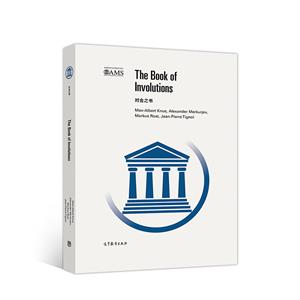Preface
Introduction
Conventions and Notations
Chapter I. Involutions and Hermitian Forms
1. Central Simple Algebras
1.A. Fundamental theorems
1.B. One-sided ideals in central simple algebras
1.C. Severi-Brauer varieties
2. Involutions
2.A. Involutions of the first kind
2.B. Involutions of the second kind
2.C. Examples
2.D. Lie and Jordan structures
3. Existence of Involutions
3.A. Existence of involutions of the first kind
3.B. Existence of involutions of the second kind
4. Hermitian Forms
4.A. Adjointinvolutions
4.B. Extension of involutions and transfer
5. Quadratic Forms
5.A. Standard identifications
5.B. Quadratic pairs
Exercises
Notes
Chapter II. Invariants of Involutions
6. The Index
6.A. Isotropic ideals
6.B. Hyperbolic involutions
6.C. Odd-degree extensions
7. The Discriminant
7.A. The discriminant of orthogonal involutions
7.B. The discriminant of quadratic pairs
8. The Clifford Algebra
8.A. The split case
8.B. Definition of the Clifford algebra
8.C. Lie algebra structures
8.D. The center of the Clifford algebra
8.E. The Clifford algebra of a hyperbolic quadratic pair
9. The Clifford Bimodule
9.A. The split case
9.B. Definition of the Clifford bimodule
9.C. The fundamental relations
10. The Discriminant Algebra
10.A. The A-powers of a central simple algebra
10.B. The canonical involution
10.C. The canonical quadratic pair
10.D. Induced involutions on A-powers
10.E. Definition of the discriminant algebra
10.F. The Brauer class of the discriminant algebra
11. Trace Form Invariants
11.A. Involutions of the first kind
11.B. Involutions of the second kind
Exercises
Notes
Chapter III. Similitudes
12. General Properties
12.A. The split case
12.B. Similitudes of algebras with involution
12.C. Proper similitudes
12.D. Functorial properties
13. Quadratic Pairs
13.A. Relation with the Clifford structures
13.B. Clifford groups
13.C. Multipliers of similitudes
14. Unitary Involutions
14.A. Odd degree
14.B. Even degree
14.C. Relation with the discriminant algebra
Exercises
Notes
Chapter IV. Algebras of Degree Four
15. Exceptional Isomorphisms
15.A. B1 = C1
15.B. A2 1 = D2
15.C. B2 = C2
15.D. A3 = D3
16. Biquaternion Algebras
16.A. Albert forms
16.B. Albert forms and symplectic involutions
16.C. Albert forms and orthogonal involutions
17. Whitehead Groups
17.A. SK1 of biquaternion algebras
17.B. Algebras with involution
Exercises
Notes
Chapter V. Algebras of Degree Three
18. Etale and Galois Algebras
18.A. Etale algebras
18.B. Galois algebras
18.C. Cubic etale algebras
19. Central Simple Algebras of Degree Three
19.A. Cyclic algebras
19.B. Classification of involutions of the second kind .
19.C. Etale subalgebras
Exercises
Notes
Chapter VI. Algebraic Groups
20. Hopf Algebras and Group Schemes
20.A. Group schemes
21. The Lie Algebra and Smoothness
21.A. The Lie algebra of a group scheme
22. Factor Groups
22.A. Group scheme homomorphisms
23. Automorphism Groups of Algebras
23.A. Involutions
23.B. Quadratic pairs
24. Root Systems
24.A. Classification of irreducible root systems
25. Split Semisimple Groups
25.A. Simple split groups of type A, B, C, D, F, and G
25.B. Automorphisms of split semisimple groups
26. Semisimple Groups over an Arbitrary Field
26.A. Basic classification results
26.B. Algebraic groups of small dimension
27. Tits Algebras of Semisimple Groups
27.A. Definition of the Tits algebras
27.B. Simply connected classical groups
27.C. Quasisplit groups
Exercises
Notes
Chapter VII. Galois Cohomology
28. Cohomology of Profinite Groups
28.A. Cohomology sets
28.B. Cohomology sequences
28.C. Twisting
28.D. Torsors
29. Galois Cohomology of Algebraic Groups
29.A. Hilbert's Theorem 90 and Shapiro's lemma
29.B. Classification of algebras
29.C. Algebras with a distinguished subalgebra
29.D. Algebras with involution
29.E. Quadratic spaces
29.F. Quadratic pairs
30. Galois Cohomology of Roots of Unity
30.A. Cyclic algebras
30.B. Twisted coefficients
30.C. Cohomological invariants of algebras of degree three
31. Cohomological Invariants
31.A. Connecting homomorphisms
31.B. Cohomological invariants of algebraic groups
Exercises
Notes
Chapter VIII. Composition and Triality
32. Nonassociative Algebras
33. Composition Algebras
33.A. Multiplicative quadratic forms
33.B. Unital composition algebras
33.C. Hurwitz algebras
33.D. Composition algebras without identity
34. Symmetric Compositions
34.A. Para-Hurwitz algebras
34.B. Petersson algebras
34.C. Cubic separable alternative algebras
34.D. Alternative algebras with unitary involutions
34.E. Cohomological invariants of symmetric compositions
35. Clifford Algebras and Triality
35.A. The Clifford algebra
35.B. Similitudes and triality
35.C. The group Spin and triality
36. Twisted Compositions
36.A. Multipliers of similitudes of twisted compositions
36.B. Cyclic compositions
36.C. Twisted Hurwitz compositions
36.D. Twisted compositions of type A
36.E. The dimension 2 case
Exercises
Notes
Chapter IX. Cubic Jordan Algebras
37. Jordan Algebras
37.A. Jordan algebras of quadratic forms
37.B. Jordan algebras of classical type
37.C. Freudenthal algebras
38. Cubic Jordan Algebras
38.A. The Springer decomposition
39. The Tits Construction
39.A. Symmetric compositions and Tits constructions
39.B. Automorphisms of Tits constructions
40. Cohomological Invariants
40.A. Invariants of twisted compositions
41. Exceptional Simple Lie Algebras
Exercises
Notes
Chapter X. Trialitarian Central Simple Algebras
42. Algebras of Degree 8
42.A. Trialitarian triples
42.B. Decomposable involutions
43. Trialitarian Algebras
43.A. A definition and some properties
43.B. Quaternionic trialitarian algebras
43.C. Trialitarian algebras of type 2D4
44. Classification of Algebras and Groups of Type D4
44.A. Groups of trialitarian type D4
44.B. The Clifford invariant
45. Lie Algebras and Triality
45.A. Local triality
45.B. Derivations of twisted compositions
45.C. Lie algebras and trialitarian algebras
Exercise
Notes
Bibliography
Index
Notation

















